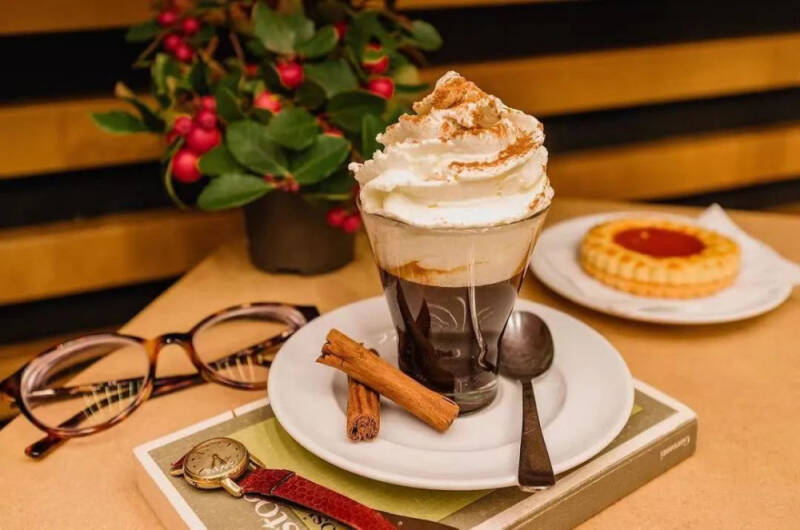Do you want an authentic cappuccino to pull flowers? Introduction to how to make Italian Coffee Cappuccino

Cappuccino, a milk coffee that has been included in the menu by countless cafes. With the development of coffee culture and trends around the world, the definition of cappuccino has been changing, and the appearance of this classic cup of coffee has changed intuitively.
How was the ancient cappuccino born? In fact, it's hard to figure out who invented the cappuccino, but looking at the data shows that the word "Cappuccino" comes from "Kapuziner", which means "monk" in German and also refers to an old-fashioned coffee.
According to legend, this drink originated in the Viennese Cafe in the 18th century. At that time, coffee was drunk with powder and water, and for better taste, a Polish named Kulczycki used a cloth bag to filter out the coffee grounds, then put it in a glass and added honey, spices and cream. It not only makes the coffee taste better, but also shows a special reddish brown, visually similar to the color of the monks of Order of Capuchin Friars Minor, so the Viennese call it "Kapuziner".

As it was introduced into Italy and with the development of pressurized coffee machine technology, Italians began to switch to espresso, sending foamy milk instead of cream, and then using spoons to shape the milk on the surface of the coffee into a pointed cap. Gradually, it also has its own Italian name, which is what we know as Cappuccino. In addition, it is said that it actually comes from the word "Capuchin". As for its "predecessor" Kapuziner, people are more accustomed to calling it Vienna Coffee (Viennese Coffee).
What does the old-school cappuccino look like?
The most popular theory about the production of cappuccino is that the proportion of coffee, milk and milk foam is 1:1:1. Take, for example, a coffee cup with a capacity of 6 ounces (about 177ml), that is, double Espresso (60ml), hot milk (60ml), and the remaining foam. The thickness of the foam made in this way is almost 2.5cm, the first two mouthfuls are almost all foam, and the bottom coffee flavor will be very strong.
In those days before the emergence of steam sticks, to get milk foam can only rely on manual handling, and the foam is relatively rough. At that time, the cappuccino was made by putting the thick bubbles into the cup with a spoon until the cup was 11 minutes full, and a small white pointed hat would be brought out of the foam layer of the spoon. At this time, the milk foam is in the form of protein cream, which is very stable, but it does not blend well with coffee.
The Golden Circle of Cappuccino
With the advent of more stressful espresso machines, the use of steam to pass away the foam has also evolved. The steam stick can not only produce dense and full foam, improve a lot of efficiency for production, but also avoid the step of spoon scraping milk bubbles. This is why the cappuccino was replaced by a smooth, protruding round "drum bag" instead of a "pointed hat".
Since then, small cups, protruding foam, strong smell of coffee, and the thick and dense feeling of thick foam have become the hallmarks of cappuccino. But it is precisely because such a thick foam layer reduces the fluidity of steamed milk, making it difficult to make a flower pattern as gorgeous as a latte, so some baristas use central injection to gently drop the foam into the Espresso, thus forming the iconic "golden circle".
The art of flower drawing makes the foam of cappuccino thinner.
Nowadays, with the popularity of flower drawing art, baristas want to outline a beautiful pattern on every cup of milk coffee, and cappuccino is no exception. In order to show a simple pattern decoration, baristas will consciously take in less air when passing away the foam, thinning the foam to improve its fluidity. In addition, considering that it is easy to leak if the cup is too full, some coffee shops that provide takeout will deliberately reduce the bulging effect of the full cup of milk foam, thus reducing the form of holding up to 11 minutes.
Of course, Qianjie believes that the so-called classic cappuccino does not mean unconditionally restoring the ancient formula. In fact, with the change of coffee bean quality, roasting degree, extraction equipment, popular taste and other factors, cappuccino has been changing with the trend. But if these changes are divorced from the characteristics of "small cups, 11 cents full, strong coffee flavor, and the full texture of thick milk foam", it may no longer be a cappuccino.
-END-
Front Street Cafe
No. 10 Baoqian street, Yandun road, Dongshankou, Yuexiu district, Guangzhou, Guangdong province
Important Notice :
前街咖啡 FrontStreet Coffee has moved to new addredd:
FrontStreet Coffee Address: 315,Donghua East Road,GuangZhou
Tel:020 38364473
- Prev

Nepal raises coffee purchase prices to ensure growers' profits and vigorously develop the coffee industry
Nepal's National Tea and Coffee Development Council (NTCDB) recently announced that the minimum purchase price for fresh coffee fruits and parchment beans will be raised by 5-30 rupees (US $0.0375-US $0.225) per kilogram to help local coffee growers increase their income. After raising the price, grade A coffee
- Next

The moment the barista crashed, 3.0pm!
▲ Click to follow | Daily boutique Coffee Culture Magazine Coffee Workshop Welcome to the familiar "barista crash moment" column version 3.0! This issue is all a famous scene, friends who click in have a "blessing"! Warm Tip: read the tweet to prepare antihypertensive medicine good news: I sorted the beans packed! Bad news: Sheng
Related
- Is espresso stored overnight in the refrigerator harmful to your body? Is frozen coffee better than freshly ground coffee?
- What parameters and proportions of water temperature should be used to grind and brew fresh coffee beans? Why can't I drink freshly roasted coffee right away?
- Customers have "changed" Manner's new products! Shop assistant: Please don't mess around!
- Remove sockets in customer areas at Starbucks stores?! Netizen: I won't go if I really tear it down
- What is the difference between the taste steps of sun-dried coffee and washed coffee? Why is sun-cured coffee sweeter and washed coffee sour?
- The recipe for salty grapefruit dirty is revealed! Coffee Festival salty grapefruit dirty coffee making materials parameters ratio milk share!
- How about the flavor of Sunlight 74158 at Sidamo Banshaha Mathieu Processing Factory in Ethiopia? 74158 Share the proportion of coffee brewing parameters!
- What effect does Italian American coffee with filter paper have? Will coffee taste better if it is put on filter paper at the bottom of the powder bowl?
- What is the color difference in coffee beans? What are the characteristics of honey processed coffee beans? Why are the anaerobically treated coffee beans uneven in color?
- How does novice Xiaobai quickly get started and make coffee? Newbies learn to make coffee by hand and share the specific steps and process process!

